Combined Convective Energy Transmission Performance of Williamson Hybrid Nanofluid over a Cylindrical Shape with Magnetic and Radiation Impressions
Abstract
:1. Introduction
2. Significance of Study
3. Mathematical Formulations
4. Numerical Method
5. Results and Discussion
6. Conclusions
- As the magnetic parameter values are increased, the rate of energy transfer, fluid velocity, and drag force decrease while the fluid temperature rises.
- There is a direct relationship between the parameter of mixed convection on the one hand, and the rate of energy transfer, drag force, and velocity of the host Williamson fluid on the other hand.
- Thermal radiation positively affects all physical quantities examined in this analysis.
- Elevating the values of the Weissenberg number causes a curb in velocity, heat transfer rate, and drag forces, as well as an increase in temperature.
- The nanoparticle combination of silver and aluminum oxide (Ag-Al2O3) has demonstrated superiority in enhancing the energy transfer rate and velocity of the host fluid.
Author Contributions
Funding
Institutional Review Board Statement
Informed Consent Statement
Data Availability Statement
Acknowledgments
Conflicts of Interest
Nomenclature
| a | Radius of cylindrical shape | U∞ | uniform free stream |
| Bo | Magnetic field strength | n | y- component of velocity |
| Cf | Skin friction coefficient | vf | Kinematic viscosity of host liquid |
| (Cp) | Heat capacity | Greek symbols | |
| f(x, y) | Dimensionless stream function | Thermal diffusivity coefficient | |
| g | Gravity vector | Thermal expansion of host liquid | |
| Gr | Grashof number | relaxation time | |
| J | Micro-inertia density | Electrical conductivity | |
| kf | Thermal conductivity | Temperature of nanoliquid | |
| M | Magnetic parameter | Vortex viscosity | |
| Nu | Nusselt Number | Combined convection parameter | |
| p | Fluid pressure | Dynamic viscosity | |
| Pr | Prandtl number | Density | |
| Rosseland diffusion approximation | Spin gradient viscosity | ||
| Re | Reynold number | Nano-solid volume fraction | |
| T | Temperature of the fluid | Stream transformation | |
| T∞ | Ambient temperature | ||
| m | x- component of velocity | Subscript | |
| ue(x) | free-stream velocity | f | Host liquid |
| M | Magnetic parameter | nf | Nanoliquid |
| s | Nanosolid | ||
References
- Williamson, R.V. The flow of pseudoplastic materials. Ind. Eng. Chem. 1929, 21, 1108–1111. [Google Scholar] [CrossRef]
- Nadeem, S.; Hussain, S.; Lee, C. Flow of a Williamson fluid over a stretching sheet. Braz. J. Chem. Eng. 2013, 30, 619–625. [Google Scholar] [CrossRef]
- Nadeem, S.; Hussain, S. Heat transfer analysis of Williamson fluid over exponentially stretching surface. Appl. Math. Mech. 2014, 35, 489–502. [Google Scholar] [CrossRef]
- Malik, M.; Bibi, M.; Khan, F.; Salahuddin, T. Numerical solution of Williamson fluid flow past a stretching cylinder and heat transfer with variable thermal conductivity and heat generation/absorption. AIP Adv. 2016, 6, 035101. [Google Scholar] [CrossRef]
- Malik, M.; Salahuddin, T.; Hussain, A.; Bilal, S.; Awais, M. Homogeneous-heterogeneous reactions in Williamson fluid model over a stretching cylinder by using Keller box method. AIP Adv. 2015, 5, 107227. [Google Scholar] [CrossRef]
- Iqbal, W.; Naeem, M.; Jalil, M. Numerical analysis of Williamson fluid flow along an exponentially stretching cylinder. AIP Adv. 2019, 9, 055118. [Google Scholar] [CrossRef]
- Ogunseye, H.; Salawu, S.; Fatunmbi, E. A numerical study of MHD heat and mass transfer of a reactive Casson–Williamson nanofluid past a vertical moving cylinder. Part. Differ. Equ. Appl. Math. 2021, 4, 100148. [Google Scholar] [CrossRef]
- Hussain, S.M.; Jamshed, W.; Pasha, A.A.; Adil, M.; Akram, M. Galerkin finite element solution for electromagnetic radiative impact on viscid Williamson two-phase nanofluid flow via extendable surface. Int. Commun. Heat Mass Transf. 2022, 137, 106243. [Google Scholar] [CrossRef]
- Loganathan, P.; Sangeetha, S. Effect of Williamson parameter on Cu-water Williamson nanofluid over a vertical plate. Int. Commun. Heat Mass Transf. 2022, 137, 106273. [Google Scholar] [CrossRef]
- Almaneea, A. Numerical study on heat and mass transport enhancement in MHD Williamson fluid via hybrid nanoparticles. Alex. Eng. J. 2022, 61, 8343–8354. [Google Scholar] [CrossRef]
- Chol, S.; Estman, J. Enhancing thermal conductivity of fluids with nanoparticles. ASME-Publ.-Fed 1995, 231, 99–106. [Google Scholar]
- Lee, S.; Choi, S.-S.; Li, S.; Eastman, J. Measuring thermal conductivity of fluids containing oxide nanoparticles. J. Heat Transf. May 1999, 121, 280–289. [Google Scholar] [CrossRef]
- Xuan, Y.; Li, Q. Heat transfer enhancement of nanofluids. Int. J. Numer. Method Heat 2000, 21, 58–64. [Google Scholar] [CrossRef]
- Xuan, Y.; Roetzel, W. Conceptions for heat transfer correlation of nanofluids. Int. J. Heat Mass Transf. 2000, 43, 3701–3707. [Google Scholar] [CrossRef]
- Eastman, J.A.; Choi, S.; Li, S.; Yu, W.; Thompson, L. Anomalously increased effective thermal conductivities of ethylene glycol-based nanofluids containing copper nanoparticles. Appl. Phys. Lett. 2001, 78, 718–720. [Google Scholar] [CrossRef]
- Heris, S.Z.; Etemad, S.G.; Esfahany, M.N. Experimental investigation of oxide nanofluids laminar flow convective heat transfer. Int. Commun. Heat Mass Transf. 2006, 33, 529–535. [Google Scholar] [CrossRef]
- Kuznetsov, A.; Nield, D. Natural convective boundary-layer flow of a nanofluid past a vertical plate. Int. J. Therm. Sci. 2010, 49, 243–247. [Google Scholar] [CrossRef]
- Tham, L.; Nazar, R.; Pop, I. Mixed convection boundary layer flow from a horizontal circular cylinder in a nanofluid. Int. J. Numer. Method Heat 2012, 22, 576–606. [Google Scholar] [CrossRef]
- Tham, L.; Nazar, R.; Pop, I. Steady mixed convection flow on a horizontal circular cylinder embedded in a porous medium filled by a nanofluid containing gyrotactic micro-organisms. J. Heat Transf. 2013, 135, 102601. [Google Scholar] [CrossRef]
- Sheremet, M.A.; Pop, I. Natural convection in a horizontal cylindrical annulus filled with a porous medium saturated by a nanofluid using Tiwari and Das’ nanofluid model. Eur. Phys. J. Plus 2015, 130, 1–12. [Google Scholar] [CrossRef]
- Dogonchi, A.; Sheremet, M.; Ganji, D.; Pop, I. Free convection of copper–water nanofluid in a porous gap between hot rectangular cylinder and cold circular cylinder under the effect of inclined magnetic field. J. Anal. Calorim. 2019, 135, 1171–1184. [Google Scholar] [CrossRef]
- Alwawi, F.A.; Alkasasbeh, H.T.; Rashad, A.; Idris, R. Heat transfer analysis of ethylene glycol-based Casson nanofluid around a horizontal circular cylinder with MHD effect. Proc. Inst. Mech. Eng. C. J. Mech. Eng. Sci. 2020, 234, 2569–2580. [Google Scholar] [CrossRef]
- Alwawi, F.A.; Hamarsheh, A.S.; Alkasasbeh, H.T.; Idris, R. Mixed Convection Flow of Magnetized Casson Nanofluid over a Cylindrical Surface. Coatings 2022, 12, 296. [Google Scholar] [CrossRef]
- Hamarsheh, A.S.; Alwawi, F.A.; Alkasasbeh, H.T.; Rashad, A.M.; Idris, R. Heat transfer improvement in MHD natural convection flow of graphite oxide/carbon nanotubes-methanol based casson nanofluids past a horizontal circular cylinder. Processes 2020, 8, 1444. [Google Scholar] [CrossRef]
- Sreedevi, P.; Reddy, P.S. Effect of magnetic field and thermal radiation on natural convection in a square cavity filled with TiO2 nanoparticles using Tiwari-Das nanofluid model. Alex. Eng. J. 2022, 61, 1529–1541. [Google Scholar] [CrossRef]
- Khan, U.; Zaib, A.; Pop, I.; Waini, I.; Ishak, A. MHD flow of a nanofluid due to a nonlinear stretching/shrinking sheet with a convective boundary condition: Tiwari–Das nanofluid model. Int. J. Numer. Method Heat 2022, 32, 3233–3258. [Google Scholar] [CrossRef]
- Jamshed, W.; Kumar, V.; Kumar, V. Computational examination of Casson nanofluid due to a non-linear stretching sheet subjected to particle shape factor: Tiwari and Das model. Numer. Methods Part. Differ. Equ. 2022, 38, 848–875. [Google Scholar] [CrossRef]
- Swalmeh, M.Z.; Shatat, F.; Alwawi, F.A.; Ibrahim, M.A.H.; Sulaiman, I.M.; Yaseen, N.; Naser, M.F. Effectiveness of Radiation on Magneto-Combined Convective Boundary Layer Flow in Polar Nanofluid around a Spherical Shape. Fractal Fract. 2022, 6, 383. [Google Scholar] [CrossRef]
- Swalmeh, M.; Alkasasbeh, H.; Hussanan, A.; Mamat, M. Numerical Study of Mixed Convection Heat Transfer in Methanol based Micropolar Nanofluid about a Horizontal Circular Cylinder. J. Phys. Conf. Ser. 2019, 1366, 012003. [Google Scholar] [CrossRef]
- Leong, K.; Ahmad, K.K.; Ong, H.C.; Ghazali, M.; Baharum, A. Synthesis and thermal conductivity characteristic of hybrid nanofluids–a review. Renew. Sustain. Energy Rev. 2017, 75, 868–878. [Google Scholar] [CrossRef]
- Muneeshwaran, M.; Srinivasan, G.; Muthukumar, P.; Wang, C.-C. Role of hybrid-nanofluid in heat transfer enhancement–A review. Int. Commun. Heat Mass Transf. 2021, 125, 105341. [Google Scholar] [CrossRef]
- Turcu, R.; Darabont, A.; Nan, A.; Aldea, N.; Macovei, D.; Bica, D.; Vekas, L.; Pana, O.; Soran, M.; Koos, A. New polypyrrole-multiwall carbon nanotubes hybrid materials. J. Optoelectron. Adv. Mater. 2006, 8, 643–647. [Google Scholar]
- Suresh, S.; Venkitaraj, K.; Selvakumar, P.; Chandrasekar, M. Synthesis of Al2O3–Cu/water hybrid nanofluids using two step method and its thermo physical properties. Colloids Surf. A Physicochem. Eng. Asp 2011, 388, 41–48. [Google Scholar] [CrossRef]
- Baghbanzadeh, M.; Rashidi, A.; Rashtchian, D.; Lotfi, R.; Amrollahi, A. Synthesis of spherical silica/multiwall carbon nanotubes hybrid nanostructures and investigation of thermal conductivity of related nanofluids. Thermochim. Acta 2012, 549, 87–94. [Google Scholar] [CrossRef]
- Moghadassi, A.; Ghomi, E.; Parvizian, F. A numerical study of water based Al2O3 and Al2O3–Cu hybrid nanofluid effect on forced convective heat transfer. Int. J. Therm. Sci. 2015, 92, 50–57. [Google Scholar] [CrossRef]
- Mehryan, S.; Izadpanahi, E.; Ghalambaz, M.; Chamkha, A. Mixed convection flow caused by an oscillating cylinder in a square cavity filled with Cu–Al2O3/water hybrid nanofluid. J. Anal. Calorim. 2019, 137, 965–982. [Google Scholar] [CrossRef]
- Aminian, E.; Moghadasi, H.; Saffari, H. Magnetic field effects on forced convection flow of a hybrid nanofluid in a cylinder filled with porous media: A numerical study. J. Anal. Calorim. 2020, 141, 2019–2031. [Google Scholar] [CrossRef]
- Alharbi, S.O.; Nawaz, M.; Nazir, U. Thermal analysis for hybrid nanofluid past a cylinder exposed to magnetic field. AIP Adv. 2019, 9, 115022. [Google Scholar] [CrossRef]
- Patil, P.; Kulkarni, M. Analysis of MHD mixed convection in a Ag-TiO2 hybrid nanofluid flow past a slender cylinder. Chin. J. Phys. 2021, 73, 406–419. [Google Scholar] [CrossRef]
- Alwawi, F.A.; Swalmeh, M.Z.; Qazaq, A.S.; Idris, R. Heat Transmission Reinforcers Induced by MHD Hybrid Nanoparticles for Water/Water-EG Flowing over a Cylinder. Coatings 2021, 11, 623. [Google Scholar] [CrossRef]
- Patil, P.M.; Benawadi, S.; Tonannavar, J.R.; Shanker, B. Homogeneous and heterogeneous reactions in the mixed convection flow of hybrid nanofluid over a slender cylinder. Asia-Pac. J. Chem. Eng. 2022, 17, e2740. [Google Scholar] [CrossRef]
- Sreedevi, P.; Reddy, P.S. Williamson hybrid nanofluid flow over swirling cylinder with Cattaneo–Christov heat flux and gyrotactic microorganism. Waves Random Complex Media 2021, 1–28. [Google Scholar] [CrossRef]
- Izady, M.; Dinarvand, S.; Pop, I.; Chamkha, A.J. Flow of aqueous Fe2O3–CuO hybrid nanofluid over a permeable stretching/shrinking wedge: A development on Falkner–Skan problem. Chin. J. Phys. 2021, 74, 406–420. [Google Scholar] [CrossRef]
- Salmi, A.; Madkhali, H.A.; Nawaz, M.; Alharbi, S.O.; Alqahtani, A. Numerical study on non-Fourier heat and mass transfer in partially ionized MHD Williamson hybrid nanofluid. Int. Commun. Heat Mass Transf. 2022, 133, 105967. [Google Scholar] [CrossRef]
- Abderrahmane, A.; Qasem, N.A.; Younis, O.; Marzouki, R.; Mourad, A.; Shah, N.A.; Chung, J.D. MHD Hybrid Nanofluid Mixed Convection Heat Transfer and Entropy Generation in a 3-D Triangular Porous Cavity with Zigzag Wall and Rotating Cylinder. Mathematics 2022, 10, 769. [Google Scholar] [CrossRef]
- Xia, W.-F.; Ahmad, S.; Khan, M.N.; Ahmad, H.; Rehman, A.; Baili, J.; Gia, T.N. Heat and mass transfer analysis of nonlinear mixed convective hybrid nanofluid flow with multiple slip boundary conditions. Case Stud. Therm. Eng. 2022, 32, 101893. [Google Scholar] [CrossRef]
- Khan, U.; Adnan; Haleema, B. Thermal performance in nanofluid and hybrid nanofluid under the influence of mixed convection and viscous dissipation: Numerical investigation. Waves Random Complex Media 2022, 1–19. [Google Scholar] [CrossRef]
- Mohammadein, A.; El-Amin, M. Thermal radiation effects on power-law fluids over a horizontal plate embedded in a porous medium. Int. Commun. Heat Mass Transf. 2000, 27, 1025–1035. [Google Scholar] [CrossRef]
- Subba Rao, A.; Amanulla, C.; Nagendra, N.; Beg, O.A.; Kadir, A. Hydromagnetic flow and heat transfer in a Williamson Non-Newtonian fluid from a Horizontal circular cylinder with Newtonian Heating. Int. J. Appl. Comput. Math. 2017, 3, 3389–3409. [Google Scholar] [CrossRef]
- Swalmeh, M.Z.; Alkasasbeh, H.T.; Hussanan, A.; Mamat, M. Influence of micro-rotation and micro-inertia on nanofluid flow over a heated horizontal circular cylinder with free convection. Theor. Appl. Mech. 2019, 46, 125–145. [Google Scholar] [CrossRef]
- Nazar, R.; Amin, N.; Pop, I. Mixed convection boundary-layer flow from a horizontal circular cylinder in micropolar fluids: Case of constant wall temperature. Int. J. Numer. Method Heat 2003, 13, 86–109. [Google Scholar] [CrossRef]
- Howell, J.R.; Mengüç, M.P.; Daun, K.; Siegel, R. Thermal Radiation Heat Transfer; CRC Press: Boca Raton, FL, USA, 2020. [Google Scholar]
- Dinarvand, S. Nodal/saddle stagnation-point boundary layer flow of CuO–Ag/water hybrid nanofluid: A novel hybridity model. Microsyst. Technol. 2019, 25, 2609–2623. [Google Scholar] [CrossRef]
- Alkasasbeh, H. Numerical solution on heat transfer magnetohydrodynamic flow of micropolar Casson fluid over a horizontal circular cylinder with thermal radiation. Front. Heat Mass Transf. 2018, 10, 32. [Google Scholar] [CrossRef]
- Cebeci, T.; Bradshaw, P. Physical and Computational Aspects of Convective Heat Transfer; Springer Science & Business Media: Berlin/Heidelberg, Germany, 2012. [Google Scholar]
- Nazar, R.M. Mathematical Models for Free and Mixed Convection Boundary Layer Flows of Micropolar Fluids; Universiti Teknologi Malaysia: Johor Bahru, Malaysia, 2004. [Google Scholar]
- Swalmeh, M.Z.; Alkasasbeh, H.T.; Hussanan, A.; Mamat, M. Numerical investigation of heat transfer enhancement with Ag-GO water and kerosene oil based micropolar nanofluid over a solid sphere. J. Adv. Res. Fluid Mech. Therm. Sci. 2019, 59, 269–282. [Google Scholar]
- Alwawi, F.A.; Alkasasbeh, H.T.; Rashad, A.M.; Idris, R. Natural convection flow of Sodium Alginate based Casson nanofluid about a solid sphere in the presence of a magnetic field with constant surface heat flux. J. Phys. Conf. Ser. 2019, 1366, 012005. [Google Scholar] [CrossRef] [Green Version]
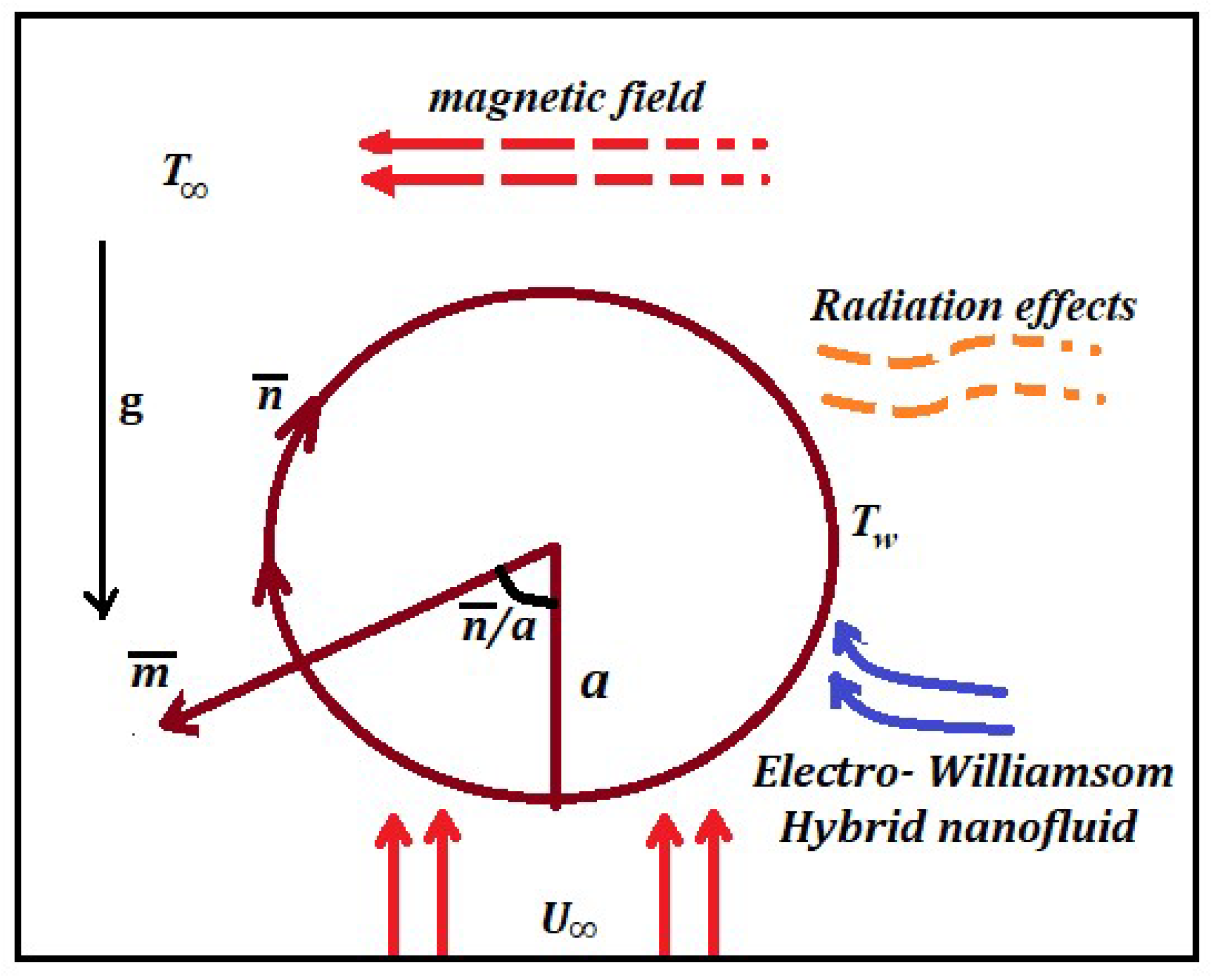


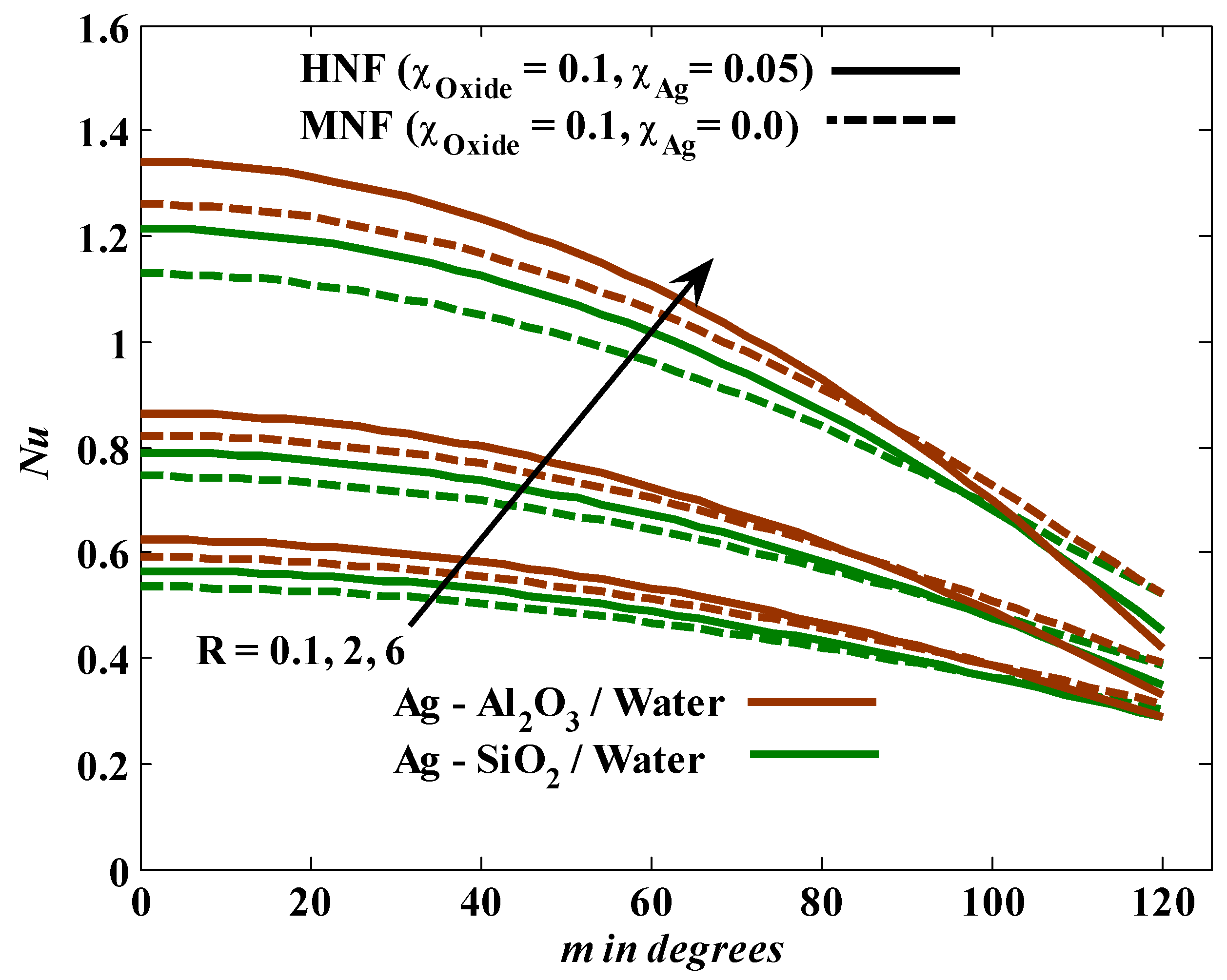


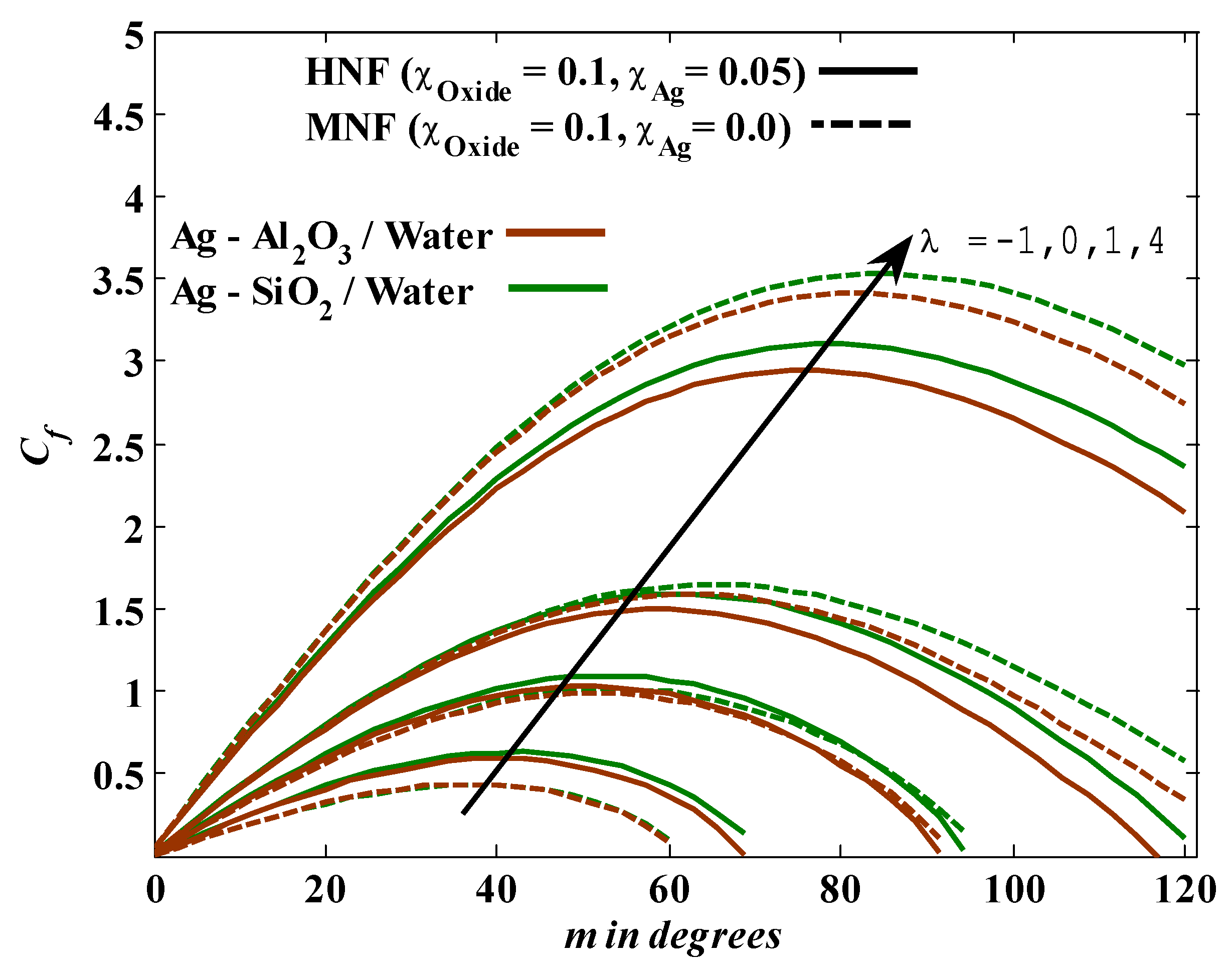
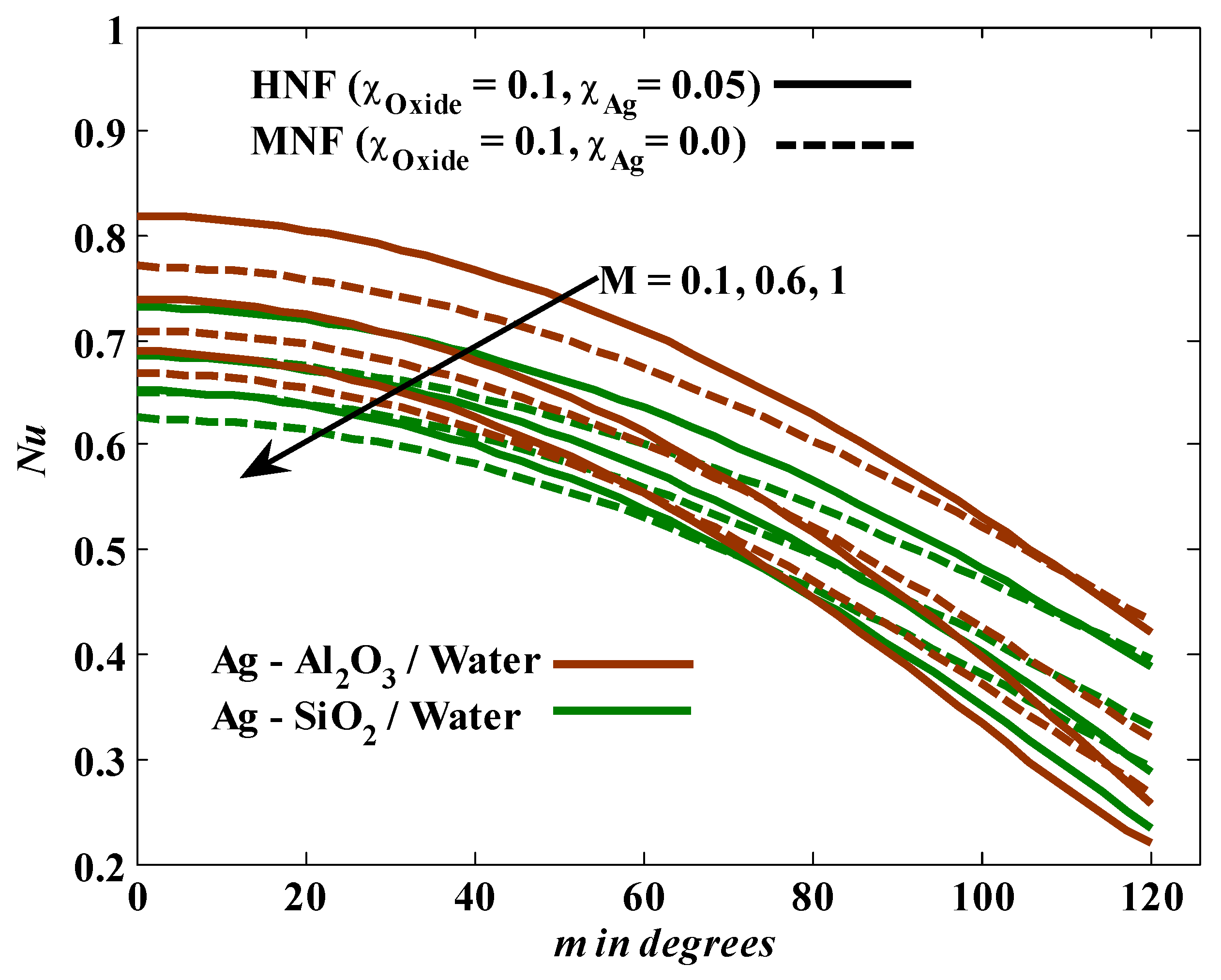
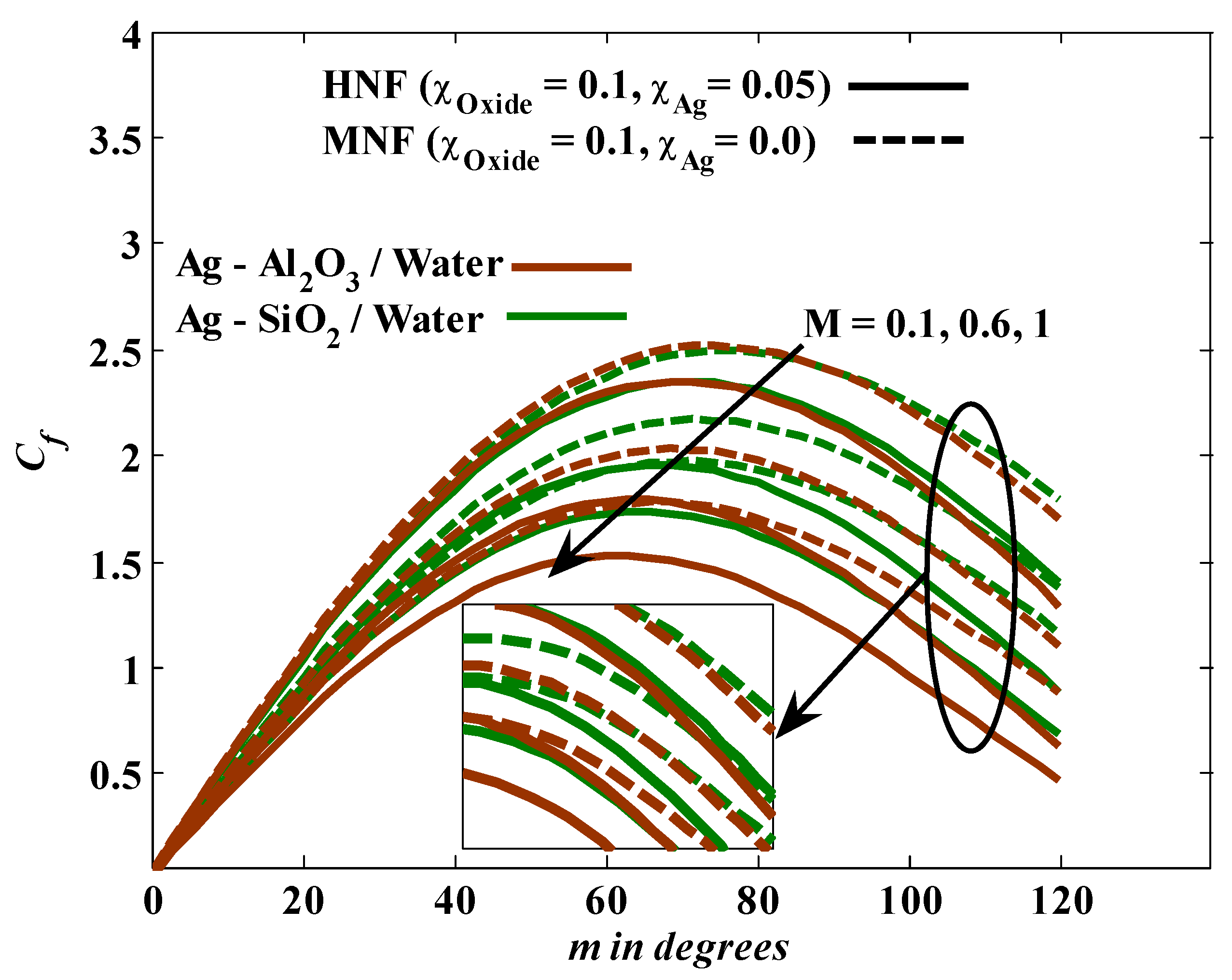
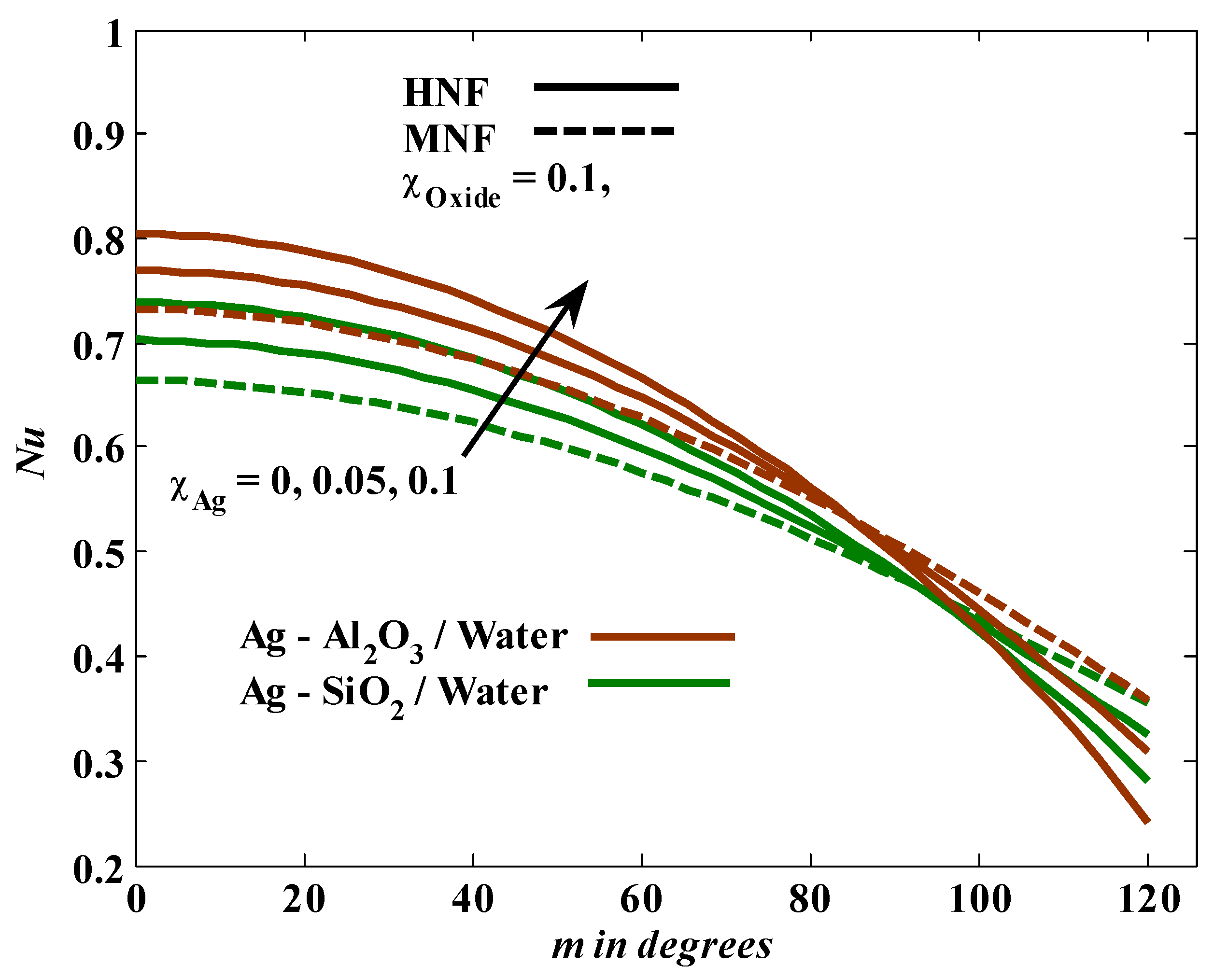

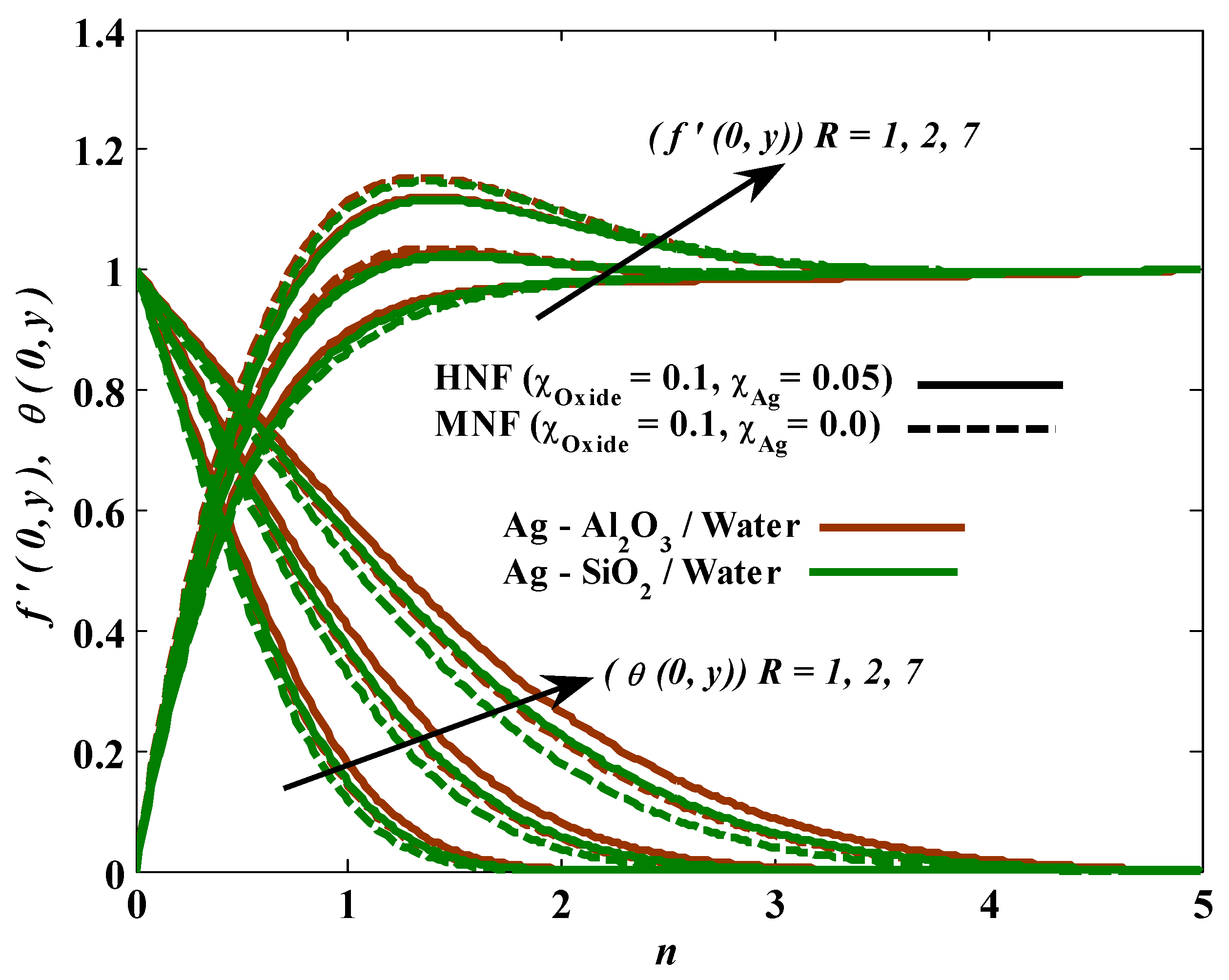
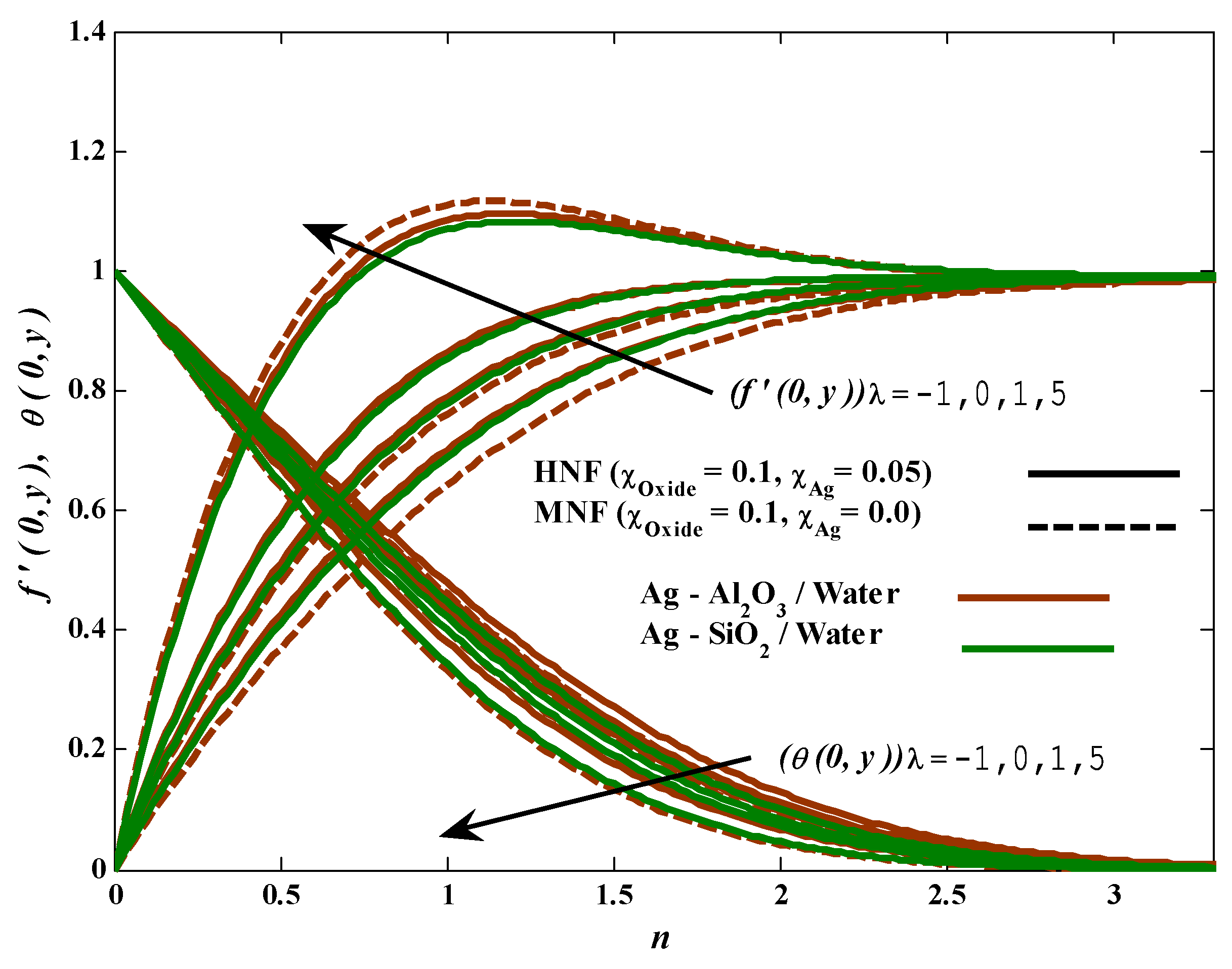
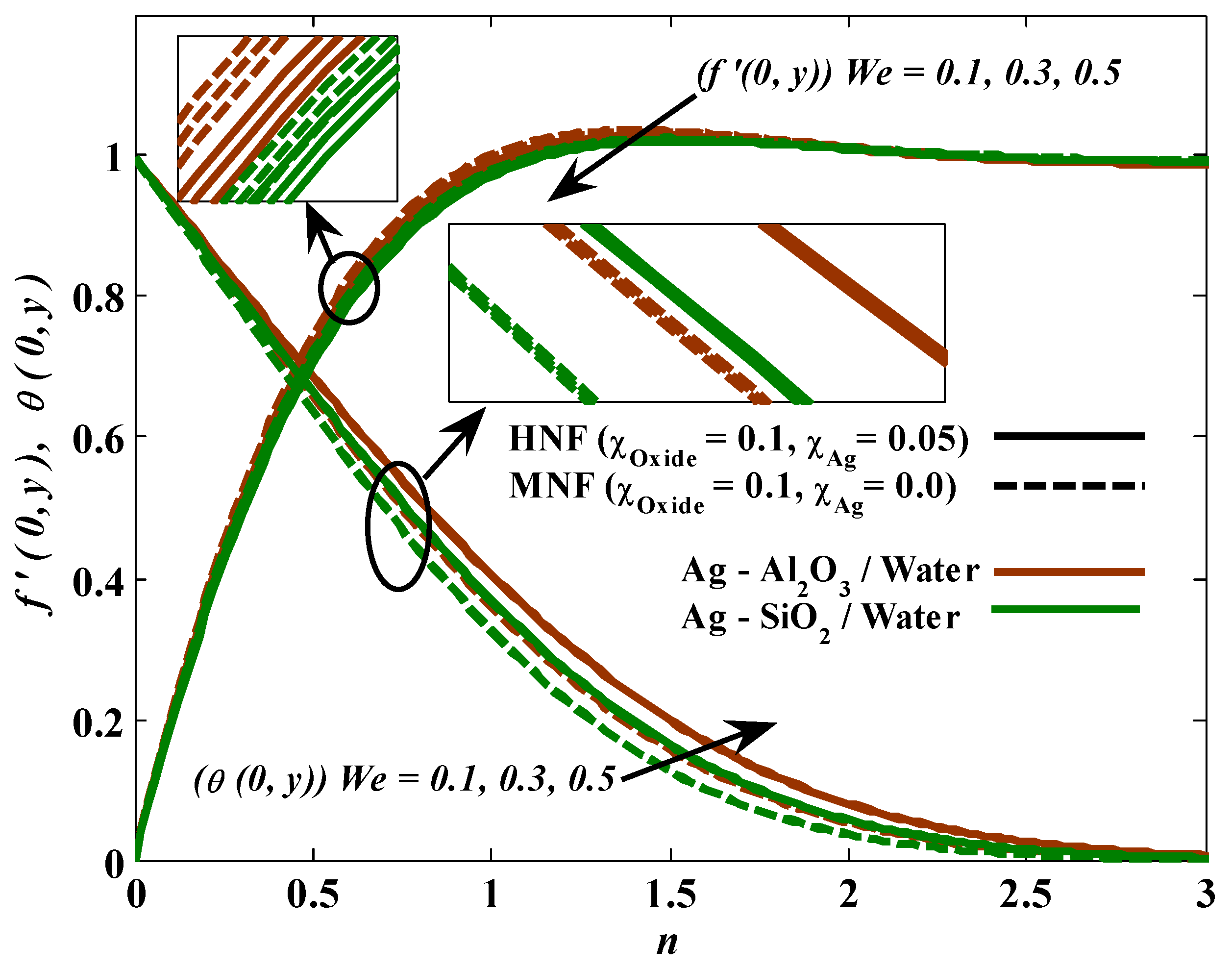
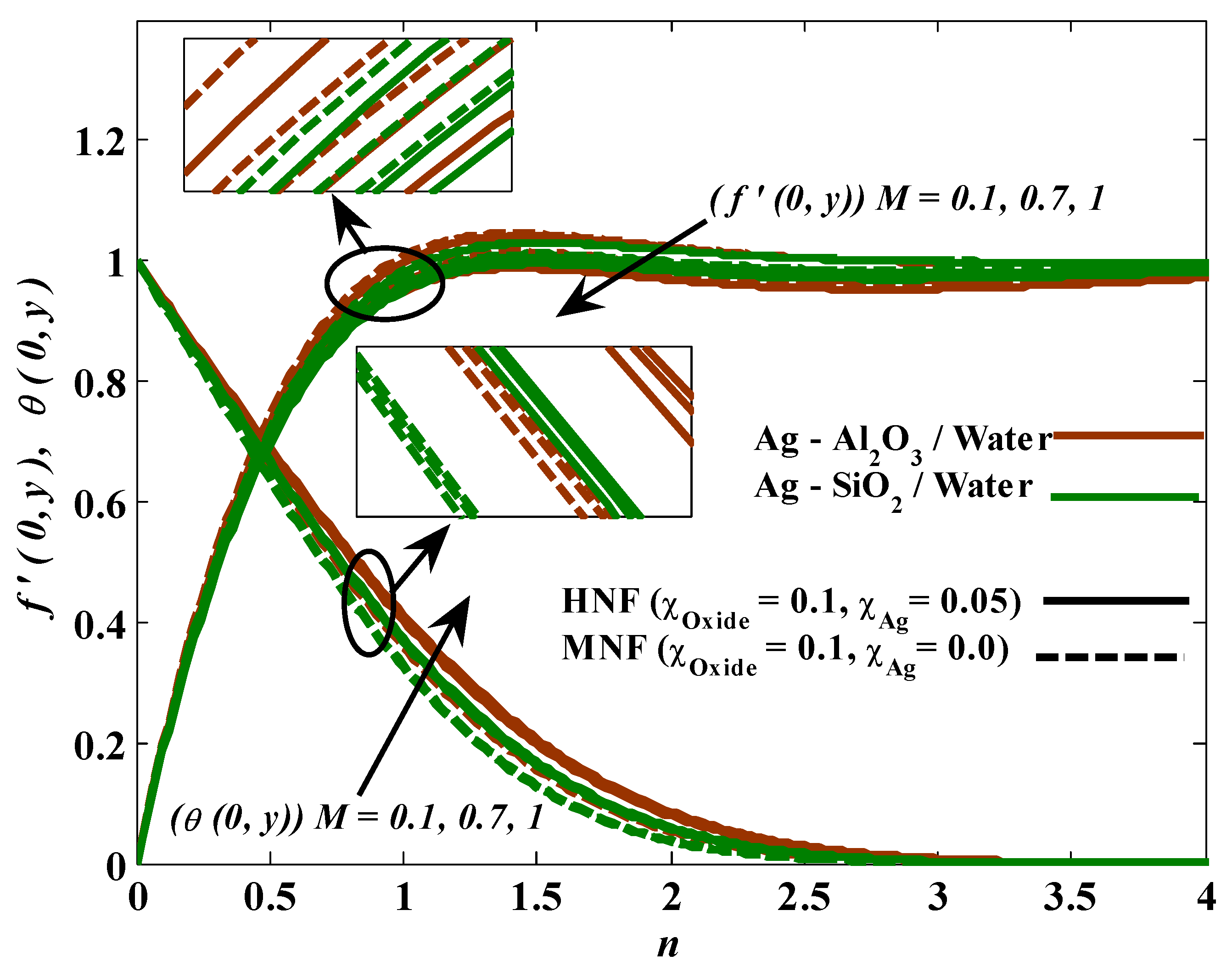
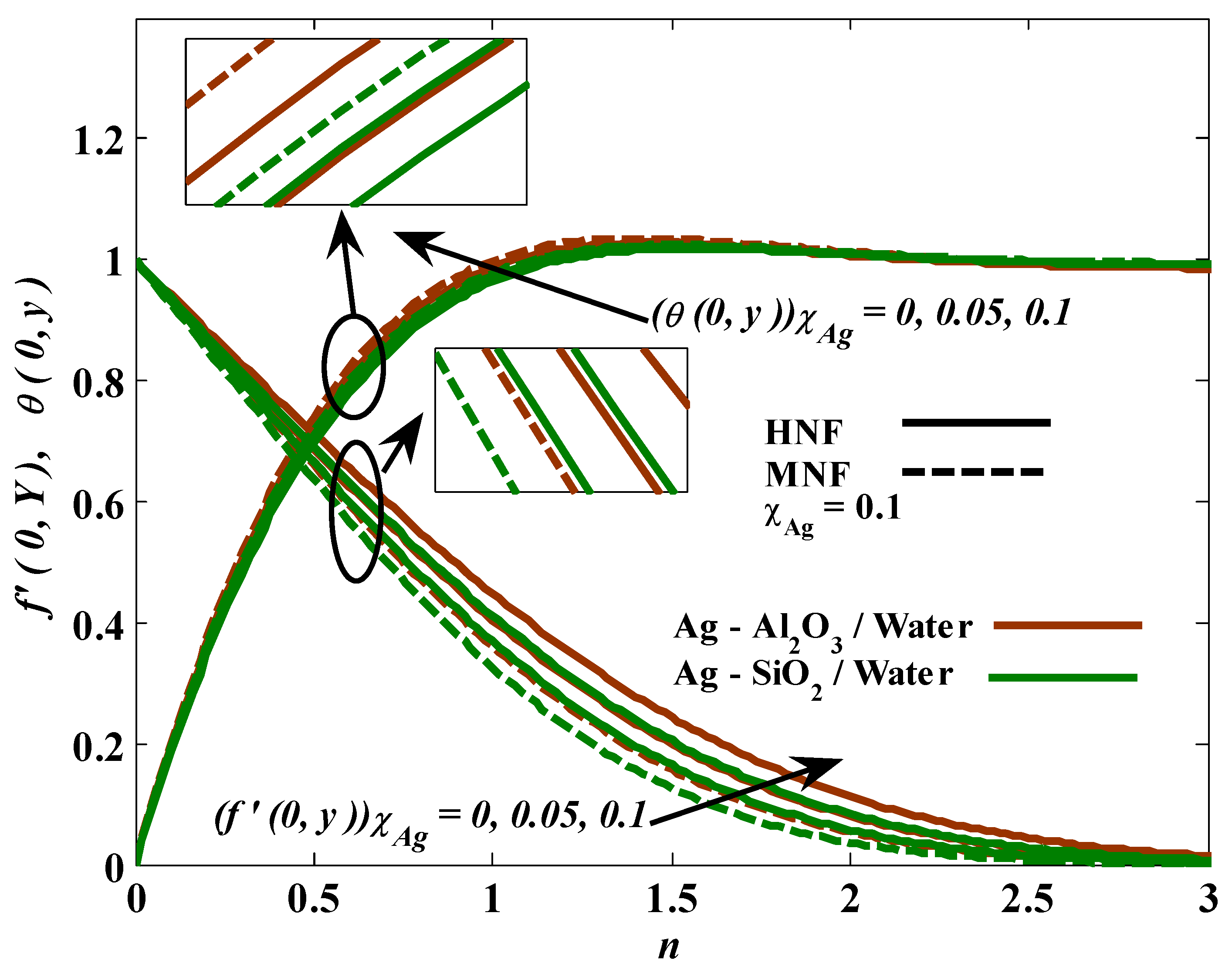
| Properties of the Mono Nanofluid | Properties of the Hybrid Nanofluid |
|---|---|
| Material | ρ (kg/m3) | Cp (J/kgK) | K (W/mK) | Β × 10−5 (K−1) | σ (s/m) | Pr |
|---|---|---|---|---|---|---|
| Water | 997.1 | 4179 | 0.613 | 21 | 5.5 × 10−6 | 6.2 |
| Ag | 10,500 | 235 | 429 | 1.89 | 6.3 × 107 | … |
| Al2O3 | 3970 | 765 | 40 | 0.85 | 3.5 × 107 | … |
| SiO2 | 2220 | 745 | 1.38 | 0.055 | 10−21 | … |
| m | ||||||||
|---|---|---|---|---|---|---|---|---|
| −2.5 | −1.5 | −1.0 | −0.5 | 0.0 | 1.0 | 1.84 | 1.85 | |
| 0o | 0.0000 | 0.0000 | 0.0000 | 0.0000 | 0.0000 | 0.0000 | 0.0000 | 0.0000 |
| (0.0000) | (0.0000) | (0.0000) | (0.0000) | (0.0000) | (0.0000) | (0.0000) | (0.0000) | |
| 0.2 | 0.0222 | 0.1236 | 0.1661 | 0.2037 | 0. 2398 | 0.3081 | 0.3626 | 0.3627 |
| (0.0226) | (0.1254) | (0.1672) | (0.2058) | (0.2421) | (0.3099) | (0.3630) | (0.3637) | |
| 0.4 | 0.2234 | 0.3077 | 0.3862 | 0.4591 | 0.5946 | 0.6988 | 0.6990 | |
| (0.2243) | (0.3093) | (0.3872) | (0.4601) | (0.5954) | (0.7012) | (0.7024) | ||
| 0.6 | 0.2693 | 0.4011 | 0.5192 | 0.6323 | 0.8348 | 0.9890 | 0.9945 | |
| (0.2721) | (0.4045) | (0.5234) | (0.6334) | (0.8358) | (0.9932) | (0.9950) | ||
| 0.8 | 0.4287 | 0.5958 | 0.7427 | 1.0135 | 1.2195 | 1.2239 | ||
| (0.4329) | (0.5968) | (0.7453) | (1.0146) | (1.2220) | (1.2244) | |||
| 1.0 | 0.3741 | 0.5927 | 0.7833 | 1.1189 | 1.3741 | 1.3762 | ||
| (0.3749) | (0.5939) | (0.7840) | (1.1203) | (1.3756) | (1.3785) | |||
| 1.2 | 0.5025 | 0.7387 | 1.1138 | 1.4454 | 1.4452 | |||
| (0.5037) | (0.7431) | (1.1480) | (1.4487) | (1.4521) | ||||
| 1.4 | 0.3068 | 0.6174 | 1.0977 | 1.4359 | 1.4446 | |||
| (0.3074) | (0.6209) | (1.0994) | (1.4425) | (1.4464) | ||||
| 1.6 | 0.4146 | 0.9783 | 1.3636 | 1.3674 | ||||
| (0.4150) | (0.9829) | (1.3648) | (1.3691) | |||||
| 1.8 | 0.0581 | 0.8082 | 1.2264 | 1.2261 | ||||
| (0.0591) | (0.8124) | (1.2290) | (1.2335) | |||||
| 2.0 | 0.6044 | 1.0487 | 1.0551 | |||||
| (0.6061) | (1.0525) | (1.0573) | ||||||
| 2.2 | 0.3698 | 0.8533 | 0.8591 | |||||
| (0.3847) | (0.8552) | (0.8601) | ||||||
| 2.4 | 0.6555 | 0.6588 | ||||||
| (0.6566) | (0.6614) | |||||||
| 2.6 | 0.4676 | 0.4771 | ||||||
| (0.4728) | (0.4772) | |||||||
| 2.8 | 0.2860 | 0.3011 | ||||||
| (0.3130) | (0.3167) | |||||||
| 3.0 | 0.1887 | |||||||
| (0.1895) | ||||||||
| 3.14 | 0.2062 | |||||||
| (0.2097) | ||||||||
Publisher’s Note: MDPI stays neutral with regard to jurisdictional claims in published maps and institutional affiliations. |
© 2022 by the authors. Licensee MDPI, Basel, Switzerland. This article is an open access article distributed under the terms and conditions of the Creative Commons Attribution (CC BY) license (https://creativecommons.org/licenses/by/4.0/).
Share and Cite
Alwawi, F.A.; Al Faqih, F.M.; Swalmeh, M.Z.; Ibrahim, M.A.H. Combined Convective Energy Transmission Performance of Williamson Hybrid Nanofluid over a Cylindrical Shape with Magnetic and Radiation Impressions. Mathematics 2022, 10, 3191. https://doi.org/10.3390/math10173191
Alwawi FA, Al Faqih FM, Swalmeh MZ, Ibrahim MAH. Combined Convective Energy Transmission Performance of Williamson Hybrid Nanofluid over a Cylindrical Shape with Magnetic and Radiation Impressions. Mathematics. 2022; 10(17):3191. https://doi.org/10.3390/math10173191
Chicago/Turabian StyleAlwawi, Firas A., Feras M. Al Faqih, Mohammed Z. Swalmeh, and Mohd Asrul Hery Ibrahim. 2022. "Combined Convective Energy Transmission Performance of Williamson Hybrid Nanofluid over a Cylindrical Shape with Magnetic and Radiation Impressions" Mathematics 10, no. 17: 3191. https://doi.org/10.3390/math10173191







